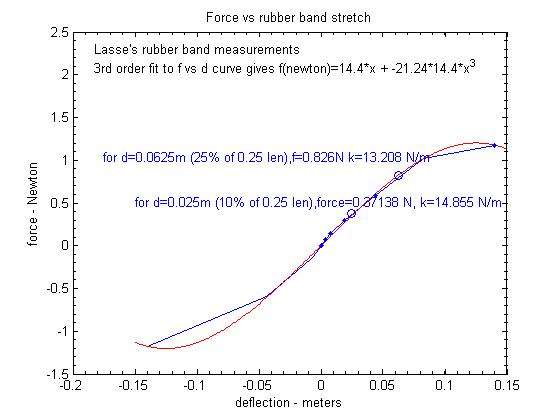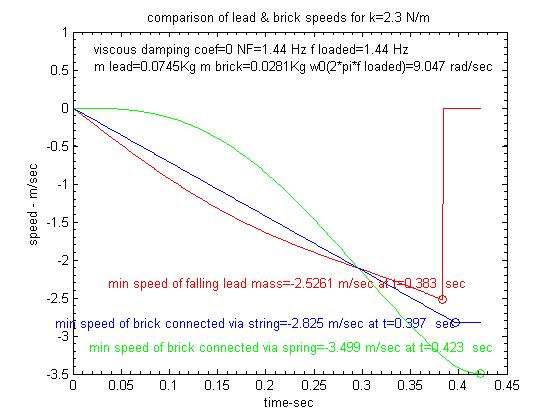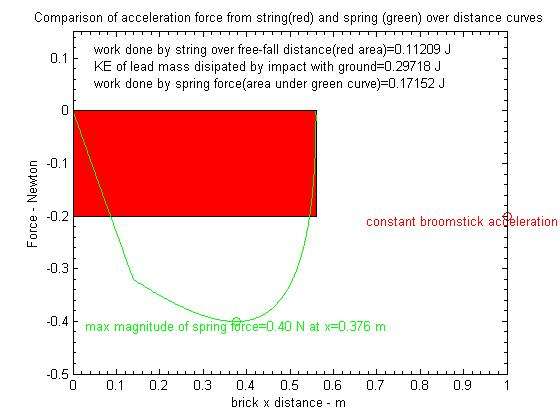Will the marble spring/combo always cover more distance than the marble/string combo or not?
Aitor,
As stated in the Thu Jan 24, 2013 10:37 am post (it appears we no longer have post numbers) to Lasse:
It is great that you can see this difference because the spring will still be deflected when the lead weight hits the ground. However, when the spring deflection returns to zero (at the maximum launch velocity point) the brick will also have traveled the same distance as the falling lead.
I know that you are focused on distance because that is something you can easily see in a video, but from a work energy standpoint distance is only half of the story. The force applied over that distance is equally important to impacting the launch velocity of the brick. In the case of the spring connection you could estimate the acceleration force on the brick by measuring the stretch in the rubber band while the lead mass falls. If you measure the distance the brick travels while the rubber band stretch goes from zero at the start to zero at the launch point, that distance should nominally equal the distance the lead mass falls assuming the friction forces opposing the acceleration force of spring on the brick can be neglected.
As Merlin explained when casting with a flexible rod, the positive acceleration force will be applied over a longer distance than it would be with a broomstick rod because the rod butt continues to rotate forward while rotation is being decelerated. With the falling lead that deceleration time is very short because of the sizable impulse force that happens as the lead hits the ground. Thus there is no additional distance traveled (aside from a small dent in your floor) in the lead mass as it rapidly decelerates to a zero velocity so the distance the brick travels while there is some stretch in the rubber band should be equal to falling distance.
I think you may also be equating distance traveled over some time period to give you an idea of the relative velocities for the brick when it is accelerated by the string or the spring. However, the acceleration of the brick when being pulled via the spring is non-linear. Thus as you can see from Merlin's plot even though the spring driven brick has traveled a smaller distance than the string driven brick when the lead hits the floor it instantaneous velocity is greater with the spring than it was with the string. It appears to me the velocity at the point where the lead mass hits the floor (the lead impact velocity is different as well) was around 5.1 m/s with the string and 5.5 m/s with the spring.
Since there is some deflection in the spring when the lead hits the floor, its PE will also add to the launch velocity of the brick by the time its stretch returns to zero. Thus the final launch velocity in Merlin's plot was around 6.2 m/s.
I understood that different spring stiffness-es could give totally opposite results. So without knowing the stiffness of Lasse's rubber band, the result was clear for you?
You are correct that the difference the model shows for Lasse's actual spring constant value was predicting a small advantage for the spring so I was jumping the gun. However, Lasse's description that there was some stretch in his rubber band when the lead mass hit the floor (i.e. the spring-driven brick had traveled a smaller distance) and the spring driven lure hit the floor at longer impact point is just what Merlin's model would have predicted. A good example of me accepting data that fits with my expectations.
However, a very stiff spring or a very weak spring would not produce opposite results. A very stiff spring would produce the same results as the string driven case. A very weak string would still add to the launch velocity, it just would not be as big as the improvement you would get with an optimum spring.
Gordy





